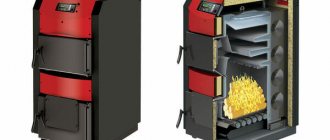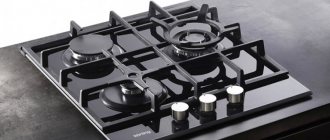There are different models of such devices, which differ in the principle of operation, accuracy and method of adjustment.
The technical parameters of stabilizers must meet the requirements for the supply voltage of electrical appliances connected to it.
The automation of gas boilers is especially sensitive to surges in the household electrical network and quickly fails when the quality of energy is low. Experts advise installing a voltage stabilizer at the installation stage of the heating system, so as not to encounter system shutdowns, freezing and breakdowns in the future.
We have collected for you the best models of protective devices presented on the Russian market in 2021 in terms of price/quality ratio.
When compiling the ratings, we focused on the technical capabilities of voltage stabilizers, price and durability.
Rating of the TOP 15 best voltage stabilizers for gas boilers in 2021
| Place | Name | Price |
| TOP 4 best voltage stabilizers for gas boilers in price/quality ratio for 2021 | ||
| 1 | Resanta ASN-10000N/1-C Lux | Find out the price |
| 2 | ENERGY APC 500 | Find out the price |
| 3 | Defender AVR Typhoon 1000 | Find out the price |
| 4 | Calm IS350 (0.3 kW) | Find out the price |
| TOP 4 best inverter voltage stabilizers for gas boilers | ||
| 1 | Shtil IS1500 (1.125 kW) | Find out the price |
| 2 | RESANTA ACH-600/1-I (0.6 kW) | Find out the price |
| 3 | BAXI Energy 400 (0.35 kW) | Find out the price |
| 4 | Calm IS550 (0.4 kW) | Find out the price |
| TOP 4 best 220 V voltage stabilizers for gas boilers | ||
| 1 | Energy ACH 5000 (2019) | Find out the price |
| 2 | RESANTA LUX ASN-5000N/1-C (5 kW) | Find out the price |
| 3 | ERA SNPT-2000-C | Find out the price |
| 4 | SVEN AVR SLIM 500 LCD (0.4 kW) | Find out the price |
| TOP 3 best voltage stabilizers for 500 W gas boilers | ||
| 1 | RESANTA LUX ASN-500N/1-C (0.5 kW) | Find out the price |
| 2 | ERA SNK-500-M (0.5 kW) | Find out the price |
| 3 | SVEN VR-L1500 (0.5 kW) | Find out the price |
How to choose a voltage stabilizer for gas boilers?
When choosing a device for protection against power surges, the main criteria should be the electrical power of the boiler itself and the parameters of the household electrical network to which it is connected.
- Voltage range . To know within what limits this parameter varies in your electrical network, invite a power quality control specialist. He will make all the necessary measurements and give recommendations for eliminating internal wiring problems, if any. Don't neglect this step! If you cannot influence the problems with overload of the transformer substation, then it is within your power to eliminate incorrect installation of electrical wiring or redistribute the load inside the house. This will protect expensive household appliances and save you money when buying a voltage stabilizer - the wider its range, the more expensive it is.
- Electric power of a gas boiler . This parameter is indicated in the technical data sheet of the equipment. Most gas boilers consume 100-200 W, but at peak load the power increases. When choosing a stabilizer, make a power reserve of 10-15% under normal power quality parameters and up to 2 times when the voltage drops in the mains up to 140 V.
- Supply line type . Choose a single-phase or three-phase device, depending on the electrical network to which it will be connected.
- Stabilization accuracy . The permissible maximum values are indicated in the technical documentation for the gas boiler, for example: 220 V ±5%.
- Mounting type . Voltage stabilizers for gas boilers are of floor and wall type. Consider how you will place the device when installing the heating system.
- Duration of operation and manufacturer's warranty . Inexpensive Chinese stabilizers last no more than 2-3 years. Manufacturers of Russian devices indicate in the documentation the service life of devices at 5-10 years.
Semiconductor (thyristor and triac) circuits
Devices with semiconductor switches - thyristors and triacs - can be built according to two principles:
- Similar to a relay circuit. The only difference is that semiconductor devices are used as a key rather than relay contacts.
- Using a transformer at the input and regulating the output voltage by changing the opening angle of thyristors (triacs).
The first circuit is similar in characteristics to the relay circuit, but has higher performance. At the same time, to control semiconductor switches, a more complex circuit is required, and they themselves have a higher cost, lower overload capacity and less time between failures.
In a circuit with an AC voltage regulator, the transformation ratio remains unchanged. The effective voltage value is stabilized by controlling the moment of unlocking the keys. This approach makes it possible to simplify and reduce the cost of the winding unit and the structure as a whole.
However, this method of regulation has its own disadvantages, the main of which is the non-sinusoidal output voltage and the high level of interference induced into the network.
Expert opinion
Grebnev Vadim Savelievich
Heating system installer
Both variants of such schemes require cooling of the switches, the power losses on which are higher than on the relay. This affects the dimensions of the structure.
What type of voltage stabilizer should I choose?
Depending on the type of adjustment, protective devices can be either smooth or discrete (stepped). The stabilization accuracy of devices of the second type depends on the number of steps and their size.
According to the principle of action, stabilizers are divided into groups:
- Electromechanical . Voltage regulation occurs by moving the autotransformer brush, which is moved by the servo drive. Mechanical type devices provide smooth and precise stabilization. They are resistant to voltage surges and quickly respond to changes in power supply parameters. However, due to wear and tear on moving parts, they require regular maintenance.
- Electronic . The devices operate on semiconductor elements - triacs, which serve as power switches. Electronic stabilizers are characterized by fast response, silent operation, the ability to withstand overloads for up to 12 hours and a long service life. The adjustment occurs on a discrete principle, with an accuracy of ±2.5%, for the most expensive models - up to 1%. Another advantage of triac models is their compactness. Please note that electronic stabilizers are more expensive than servo and relay ones.
- Relay . The simplest and most inexpensive devices. They are characterized by low output adjustment accuracy ±5-10%, so they are not suitable for all models of gas boilers. Their other disadvantages: noise, slow response, low reliability, inability to withstand overloads.
- Inverter . They are distinguished by a wide range of operating input voltage (115-300 V) and an efficiency of more than 90%. Also, these devices provide the smoothest and fastest adjustments, operate without noise and are easy to install due to their compact size. Disadvantages: high cost and sensitivity to increased load.
Criterias of choice
The main criterion for choosing a stabilizer is its type; the operating principle and characteristics of the device, its reliability, the possibility of installation in a boiler room, noise and cost depend on this.
Relay. The simplest and most inexpensive devices. The main element in them is a transformer, the primary winding of which is supplied with incoming power. The secondary winding has from 5 to several dozen circuits (the accuracy of stabilization depends on their number). Depending on the input voltage, the device automatically switches the power to the secondary winding circuit, which will produce a voltage as close as possible to 220 V. The role of the switch is performed by relays (electromechanical switches) enclosed in a sealed housing that prevents open sparking. Relay stabilizers have excellent response speed, are resistant to overloads, have a wide range of input voltage, and due to their simplicity of design, they are wear-resistant and durable, not requiring attention or replacement of working elements. However, even if there are more than 10 secondary winding circuits, they are characterized by large deviations, within 7-10%, which in the case of gas boilers is not critical, because even vulnerable models can easily tolerate voltage deviations of up to 10-15% from 220 V. The only really noticeable drawback is that even modern relays click quite loudly when switching.
Electronic. Also called triac or thyristor, they use triacs or thyristors as switches for switching. In the case of using relays, their number depends on the dimensions of the device; it is impossible to install a large number of relays in a compact case, while compact triacs or thyristors can be installed. The result is a device with a larger number of switching stages, and therefore a more accurate output voltage. Semiconductor switches also mean faster, quieter switching, reliability and durability. However, the price of electronic stabilizers is quite high and using a device costing 6 thousand rubles or more, the functionality of which is aimed only at stabilization, is a controversial decision. Considering that for almost any gas boiler a conventional relay stabilizer will be sufficient.
Inverter. The best option for any application, including connecting a gas boiler. Inverter stabilizers (also known as double conversion) are characterized by maximum accuracy, a pure sine wave, filtered from interference. Without going into unnecessary details, the operating principle of inverter voltage stabilizers is simple:
- At the input, the alternating current of the household electrical network is converted into direct current.
- At the output, direct current passes through the inverter and is converted into alternating current, with a voltage of 220 V and a pure sine wave with a frequency of 50 Hz.
Thanks to double conversion, we always have stable and desired output values, regardless of the voltage parameters and interference in the electrical network at home. Deviations in voltage stabilization in inverter devices reach 1% or less, which is the best result to date.
Minimum required power. Its cost greatly depends on the rated power of the stabilizer, so simply choosing the most productive one and not bothering is not the most justified solution. If you have already decided on the boiler model, just open its operating instructions (or find an electronic copy of it) and see the maximum power consumption. In the instructions, it is usually indicated in the technical characteristics table as rated electrical power (W). The main thing is not to be confused with the thermal power of the boiler (kW). For example, the well-known BAXI ECO-4s 24F consumes up to 130 W; it is also worth considering that starting power (for example, when igniting or starting a pump) can increase instantaneous consumption, up to + 100 W. A certain reserve is also required, we recommend setting aside about 40%, that is, we multiply the indicator by 1.4, total - (130 W + 100 W) * 1.4 = 322 W. Almost all models are characterized by consumption from 100 to 180 W, so for a standard gas boiler you need a 400 W stabilizer that is not particularly strong in power, it will be more than enough. Please note that some models indicate power in Volt-Amps (VA) rather than Watts (W). To convert to Watts, you need to multiply the number in Va by 0.7-0.9 (the value is always different and depends on the power factor (cos φ) of the model). There are also more complex automated boilers with several circulation pumps that consume both 450 and 500 W, but you will definitely know about its increased consumption in advance. If you plan to use more than one circulation pump, you can calculate the required power using the simple calculator below.
Operating voltage range. The optimal values are within 140-260 V at the input. Of course, the wider this range, the more problematic the power supply network the stabilizer will work. If the voltage in the electrical network goes beyond the operating parameters of the stabilizer, the load will be de-energized. And here there is an important point: models that are not equipped with emergency protection can fail if a voltage surge exceeds their limit, and it’s good if they “take the blow” only on themselves. Models equipped with protection will interrupt the power supply without any consequences, and some of them are able to restore power supply automatically. It is also worth considering that the power of most models is greatly reduced when operating at low voltages (120-160 V) and not all manufacturers indicate this.
Reaction time. The decision speed of modern stabilizers is in the range of 4-20 ms. In practice, most boilers do not react in any way to instability for even 20 ms, and some models even to short-term switching on and off from the outlet manually, so the performance parameter is not critically important. However, there are more sensitive models, for which even an 8 ms response will be more than enough. By the way, inverter stabilizers have no response time at all, since their output voltage is absolutely stable and does not depend on the input parameters.
Precision stabilization. Despite the fact that almost all stabilizers show exactly 220 V on the electronic display, the actual voltage may have an error. This “deception” is more likely to ensure that the average, inexperienced user does not worry about indicators, for example, 240 V. Indeed, according to modern standards GOST 29322-2014, a voltage in the range of 207 - 253 V is considered normal. And in practice, gas boilers really work normally within this limit, and most even have instructions stating permissible deviations within +-10% of 230 V. An exception, as in the case of the previous point, can only be ultra-sensitive models, for which it is better to select a stabilizer with accuracy 5% or less. In other cases, modern, even the cheapest, stabilizers allow output deviations of no more than 7-8%.
Other. Finally, there are several important points that also need to be taken into account:
- The method of placing the device can be either wall-mounted or floor-mounted. Of course, for wall-mounted heating boilers, the floor-standing option is not convenient, unless there are free shelves of the required size next to the boiler;
- body material – preferably metal, although not always aesthetically pleasing, but resistant to high temperatures typical of stabilizers;
- We choose exclusively a single-phase device.











